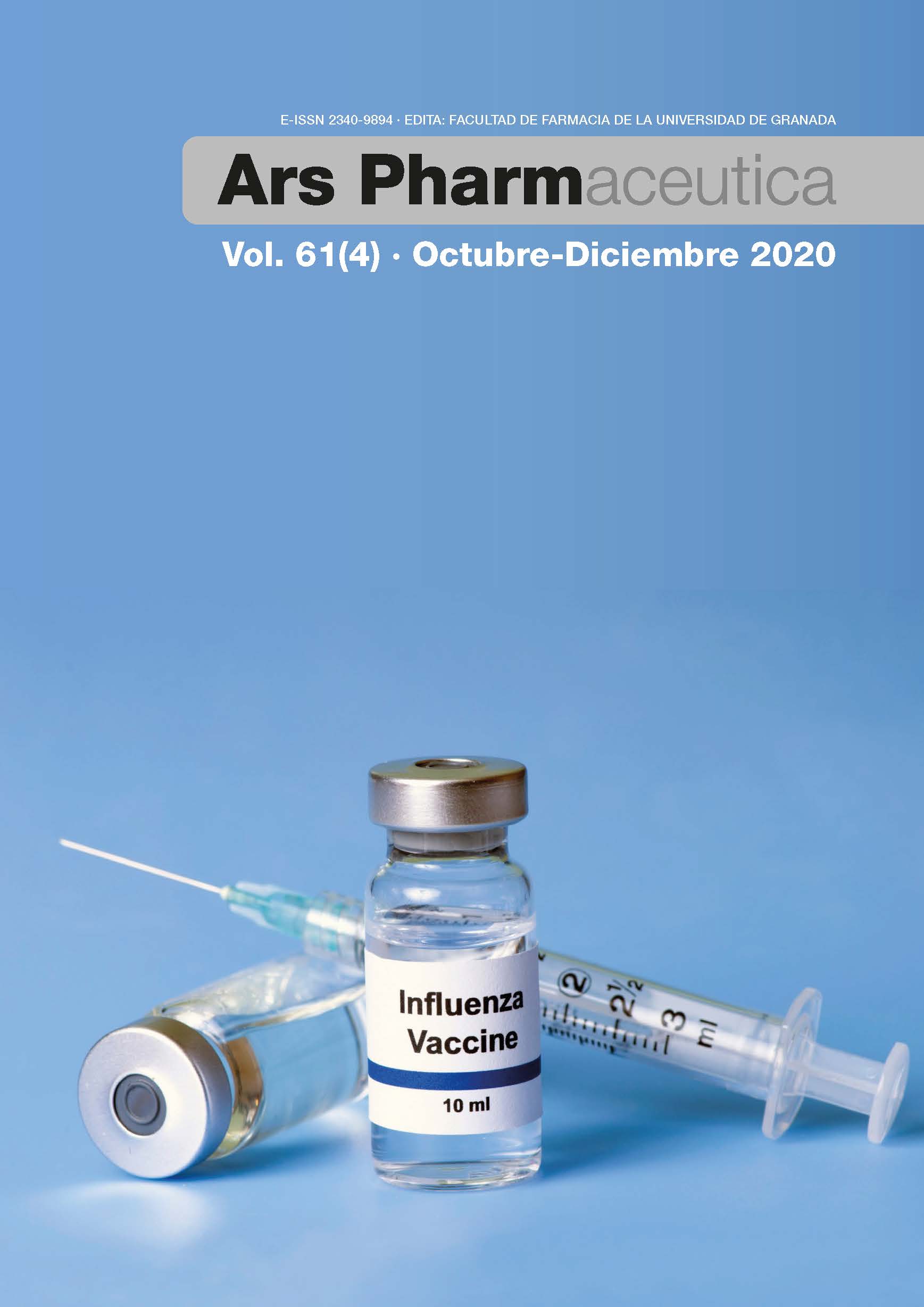Candidatos potenciales farmacológicos inhibidores de proteasa transmembrana de serina 2 en el tratamiento de 2019-ncov.
Palabras clave:
TMPRSS2, ACE II, COVID-19, 2019-nCoV, CoronaviridaeResumen
Introducción: La Enfermedad por coronavirus 2019 (COVID-19) causada por el virus SARS-CoV-2, con característica de infectar el tracto respiratorio causando un síndrome respiratorio agudo como paso inicial para ingresar a la célula huésped el virus usa los receptores ACE II y la proteína transmembrana TMPRSS2 para causar la infección, Por lo que se ha descrito diferentes tipos de fármacos para realizar su inhibición en la adhesión del paso inicial.
Metodología: Revisión no sistemática de artículos con la ayuda de palabras clave preestablecidas.
Resultados: En esta revisión presentaremos fármacos que inhiben este tipo de receptor, por lo tanto, estos medicamentos podrían considerarse candidatos potenciales para mitigar la propagación del SARS-CoV-2.
Descargas
Citas
Ruiz-Bravo A, Jimenez-Varela M. SARS-CoV-2 y pandemia de síndrome respiratorio agudo (COVID-19). Ars Pharm. 2020; 61(2), 63-79. doi:10.30827/ars.v61i2.15177.
Montes A, Coronell W, Baldiris R. Can house flies mechanically carry and/or transport sars-cov-2? Int J Clin Virol. 2020; 4: 076-078. doi: 10.29328/journal.ijcv.1001019.
Corman V, Lienau J, Witzenrath M. Coronaviruses as the cause of respiratory infections. Der Internist. 2019; 60(11): 1136-1145. doi: 10.1007/s00108-019-00671-5.
WHO. Coronavirus diastase (COIVD-2019) situation reports [Internet] 2020 Available in: https://www.who.int/emergencies/diseases/novel-coronavirus-2019/situation-reports/.
Liu J, Liao X, Qian S, Yuan J, Wang F, Liu Y, Zhang Z. Community Transmission of Severe Acute Respiratory Syndrome Coronavirus 2. Emerging infectious diseases Shenzhen, China. Emerg Infect Dis. 2020; 26(6). doi:10.3201/eid2606.200239.
Ong S, Tan Y, Chia P, Lee T, Ng O, Wong M, Marimuthu K. Air, surface environmental, and personal protective equipment contamination by severe acute respiratory syndrome coronavirus 2 (SARS-CoV-2) from a symptomatic patient. JAMA. 2020;323(16):1610–1612. doi:10.1001/jama.2020.322.7
Xiao K, Zhai J, Feng Y, Zhou N, Zhang X, Zou J, Zhang Z. Isolation and characterization of 2019-nCoV-like coronavirus from Malayan pangolins. BioRxiv. 2020; 02.17.951335; doi:10.1101/2020.02.17.951335.
Hoffmann M, Kleine-Weber H, Schroeder S, Krüger N, Herrler T, Erichsen S, Müller M. SARS-CoV-2 cell entry depends on ACE2 and TMPRSS2 and is blocked by a clinically proven protease inhibitor. Cell. 2020; 181, 271–280. doi:10.1016/j.cell.2020.02.052
Ueda M, Uchimura K, Narita Y, Miyasato Y, Mizumoto T, Morinaga J, Shiraishi N. The serine protease inhibitor camostat mesilate attenuates the progression of chronic kidney disease through its antioxidant effects. Nephron 2015; 129:223-232. doi:10.1159/000375308.
Bittmann S, Luchter E, Weissenstein A, Villalon G, Moschüring-Alieva E. TMPRSS2-Inhibitors Play a Role in Cell Entry Mechanism of COVID-19: An insight into Camostat and Nafamostat. J Regen Biol Med. 2020; 2(2): 1-3. doi:10.37191/Mapsci-2582-385X-2(2)-022
Yamamoto M, Kiso M, Sakai-Tagawa Y, Iwatsuki-Horimoto K, Imai M, Takeda M, Matsuda Z. The anticoagulant nafamostat potently inhibits SARS-CoV-2 infection in vitro: an existing drug with multiple possible therapeutic effects. bioRxiv. 2020.04.22.054981; doi:10.1101/2020.04.22.054981
Lucas J, Heinlein C, Kim T, Hernandez S, Malik M, True L, Clegg N. The androgen-regulated protease TMPRSS2 activates a proteolytic cascade involving components of the tumor microenvironment and promotes prostate cancer metastasis. Cancer Discov. 2014; 4(11): 1310-1325. doi: 10.1158/2159-8290.CD-13-1010.
Shen L, Mao H, Wu Y, Tanaka Y, Zhang W. TMPRSS2: A potential target for treatment of influenza virus and coronavirus infections. Biochimie. 2017;142:1-10. doi:10.1016/j.biochi.2017.07.016
Böttcher-Friebertshäuser E, Stein D, Klenk H, Garten W. Inhibition of influenza virus infection in human airway cell cultures by an antisense peptide-conjugated morpholino oligomer targeting the hemagglutinin-activating protease TMPRSS2. J Virol. 2011; 85(4): 1554-1562. doi: 10.1128/JVI.01294-10
Limburg H, Harbig A, Bestle D, Stein D, Moulton H, Jaeger J, Koczulla A. TMPRSS2 is the major activating protease of influenza A virus in primary human airway cells and influenza B virus in human type II pneumocytes. J Virol. 2019; 93(21): e00649-19. doi:10.1128/JVI.00649-19.
Bestle D, Heindl M, Limburg H, Pilgram O, Moulton H, Stein D, Becker S. TMPRSS2 and furin are both essential for proteolytic activation and spread of SARS-CoV-2 in human airway epithelial cells and provide promising drug targets. bioRxiv. 2020.04.15.042085; doi:10.1101/2020.04.15.042085
Zuñiga J, Cortes A. The role of additive manufacturing and antimicrobial polymers in the COVID-19 pandemic. Expert Rev Med Devices. 2020.17:6, 477-481, doi: 10.1080/17434440.2020.1756771
Nickols N, Dervan P. Suppression of androgen receptor-mediated gene expression by a sequence-specific DNA-binding polyamide. PNAS. 2007; 104(25): 10418-10423. doi: 10.1073/pnas.0704217104.
Puc J, Kozbial P, Li W, Tan Y, Liu Z, Suter T, Ohgi K, Zhang J, Aggarwal A. Rosenfeld M.G. Ligand-dependent enhancer activation regulated by topoisomerase-I activity. Cell. 2015; 160:367–380.doi: 10.1016/j.cell.2014.12.023
Corponi F, Fabbri C, Bitter I, Montgomery S, Vieta E, Kasper S, Pallanti S, Serretti A. Novel antipsychotics specificity profile: A clinically oriented review of lurasidone, brexpiprazole, cariprazine and lumateperone. Eur Neuropsypharm. 2019; 29(9): 971–985. doi:10.1016/j.euroneuro.2019.06.008
Elmezayen A, Al-Obaidi A, Şahin A. T, Yelekçi K. Drug repurposing for coronavirus (COVID-19): in silico screening of known drugs against coronavirus 3CL hydrolase and protease enzymes. J Biomol Struct Dyn 2020; 1-12.doi: 10.1080/07391102.2020.1758791
Alan C, Real J. P, Palma S. D. High Dose Of Ascorbic Acid Used In Sars Covid-19 Treatment: Scientific And Clinical Support For Its Therapeutic Implementation. Ars Pharm. 2020. 61(2), 145-148.doi: 10.30827/ars.v61i2.15164.
Descargas
Publicado
Cómo citar
Número
Sección
Licencia
Los artículos que se publican en esta revista están sujetos a los siguientes términos en relación a los derechos patrimoniales o de explotación:
- Los autores/as conservarán sus derechos de autor y garantizarán a la revista el derecho de primera publicación de su obra, la cual se distribuirá con una licencia Creative Commons BY-NC-SA 4.0 que permite a terceros reutilizar la obra siempre que se indique su autor, se cite la fuente original y no se haga un uso comercial de la misma.
- Los autores/as podrán adoptar otros acuerdos de licencia no exclusiva de distribución de la versión de la obra publicada (p. ej.: depositarla en un archivo telemático institucional o publicarla en un volumen monográfico) siempre que se indique la fuente original de su publicación.
- Se permite y recomienda a los autores/as difundir su obra a través de Internet (p. ej.: en repositorios institucionales o en su página web) antes y durante el proceso de envío, lo cual puede producir intercambios interesantes y aumentar las citas de la obra publicada. (Véase El efecto del acceso abierto).




















